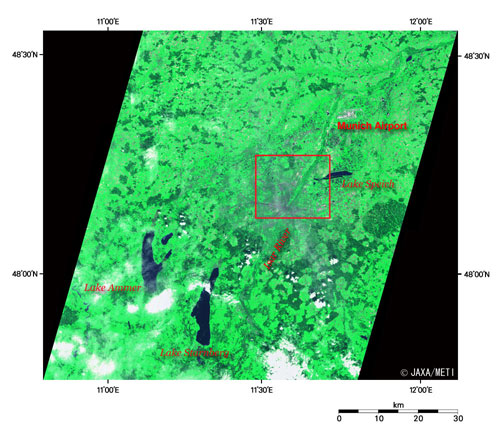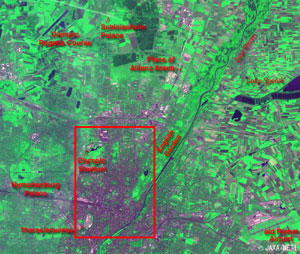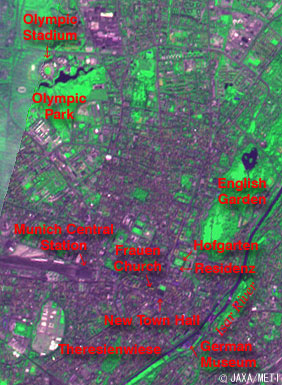Seen from Space 2006
Munich: The capital of the German Federal State of Bavaria
In this issue, we introduce Munich, where the opening game of the World Cup football was played.
Munich is located in Southern Bavaria 50 km from the northern end of the Alps, on a plain 500 m above sea level. The warm wind blowing beyond the Alps is called a föhn (foehn) in German and sometimes brings a rapid rise in air temperaure. The "föhn" of the föhn Phenomenon is derived from this wind.
It is called "WM Stadion Munich" during the World Cup. Lake Speich is on the right, and the Isar River flows from the bottom to the upper right. The old Riehm Airport can be seen in the lower right area of the image, but it was closed after the opening of the Franz Josef Strauss Airport. The New Munich Trade Fair Center was constructed on the vacant lot and opened in February 1998. You can see the Schleißheim (Schleissheim) Palace and Olympic Regatta Course at the top. The palace was built during the 18th century as the summer palace for the Wittelsbach family, who governed the Dukedom of Bavaria (the Kingdom of Bavaria since 1806) from 1180 to 1918. The Nymphenburg Palace on the lower left is also a summer palace built in the 17th to 19th century also for Wittelsbach family.
The world's largest beer festival, known as "Oktoberfest," is held every year from mid-September to the beginning of October (September 16 to October 3 in 2006) at Theresienwiese, which can be seen in the lower left area of the image. The festival originated with the promenade race held commemorating the marriage of Crown Prince Ludwig in the Kingdom of Bavaria on October 12, 1810. The venue is called Theresienwiese (Therese's lawn) for Crown Princess Therese. The Munich Central Station can be seen in black on the northeastern side of Theresienwiese. The New Town Hall, which was built between the second half of the 19th century to the beginning of the 20th century, is on the east side of Munich Central Station. The Frauen Church, with its onion-domed twin towers, is just above and to the left of the New Town Hall and is the symbol of Munich. The Residenz just to the upper right of the New Town Hall was the residence castle built for Wittelsbach family during the 14th to 18th century. At present, it is used as the museum and the treasury. The Bavarian State Opera is also accommodated there. Hofgarten (the royal garden) can be seen on the northern side of the Residenz. The German Museum, which is on a sandbank (in the lower right) in the Isar River, is one of the biggest and the oldest science museums in the world. Munich and Sapporo, Japan, are twin cities based on the relationship that the1972 Winter Olympics was hosted in Sapporo and the 1972 Summer Olympics hosted in Munich.
|
||||||||||||||||||||||







